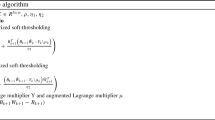Abstract
Hyperspectral image(HSI) anomaly detection, as one of the hottest topics in current remote sensing information processing and image processing,has important theoretical value and has been widely used in military and civilian applications. Anomaly detection aims to detect and label small man-made abnormal targets or objects without any prior knowledge. In this paper, we proposed a segmented three-order Tucker decomposition for HSI anomaly detection. There are three major steps:1) the original HSI data is divided along the three dimensions into a grid of multiple of small-sized sub-tensors. 2)Tucker decomposition followed by anomaly detection algorithm is applied onto each sub-tensor. 3) the detection results from those sub-tensors are fused. Experiments reveal that the proposed method outperforms other current anomaly detectors with better detection performance. Finally, we introduce the application of hyperspectral image anomaly detection algorithm in the Internet of things(IOT).








Similar content being viewed by others
References
Andersson CA, Henrion R (1999) A general algorithm for obtaining simple structure of core arrays in N-way PCA with application to fluorimetric data. Comput Statist Data Anal 31:255–278
Bioucas-Dias JM, Plaza A, Camps-Valls G, Scheunders P, Nasrabadi N, Chanussot J (2013) Hyperspectral remote sensing data analysis and future challenges. IEEE Geosci Remote Sens Mag 1(2):6–36
Carlotte MJ (2005) A cluster-based approach for detecting man-made objects and changes in imagery. IEEE Trans Geosci Remote Sens 43(2):374–387
Chang CI, Chiang SS (2002) Anomaly detection and classification for hyperspectral imagery. IEEE Trans Geosci Remote Sens 40(1):1314–1325
Chang CI, Du Q (2004) Estimation of number of spectrally distinct signal sources in hyperspectral imagery. IEEE Trans Geosci Remote Sens 42(3):608–619
Chen SY, Yang S, Kalpakis K, Chang CI (2013) Low-rank decomposition-based anomaly detection, in Proc. SPIE Def., Secur., and Sens. Intern Soc Optics Photonics 87430N
Du B, Zhang L (2011) Random selection based anomaly detector for hyperspectral imagery. IEEE Trans Geosci Remote Sens 49(5):1578–1585
Fowler JE, Du Q (2012) Anomaly detection and reconstruction from random projections. IEEE Trans Image Process 21(1):184–195
Govender M, Chetty K, Bulcock H (2007) A review of hyperspectral remote sensing and its application in vegetation and water resource studies. Water SA (Pretoria) 33:145–151
Gupta A, Oberoi A (2015) A comparative analysis of tensor decomposition models using hyperspectral image. Inter J of Comput Sci Trends and Tech (IJCST) 3(2):5–11
Hsueh M, Chang CI (2004) Adaptive causal anomaly detection for hyperspectral imagery. In IEEE Intern Geosci Remote Sens Symp 5:3222–3224
Jia X (1996) Classification techniques for hyperspectral remote sensing image data, Ph.D. dissertation, Sch. Elect. Eng., Univ. College, ADFA, Univ. New South Wales
Jia X, Richards JA (1994) Efficient maximum likelihood classification for imaging spectrometer data sets. IEEE Trans Geosci Remote Sensing 32:274–281
Kerekes J (2008) Receiver operating characteristic curve confidence intervals and regions. IEEE Geosci Remote Sens Lett 5(2):251–255
Khazai S, Homayouni S, Safari A, Mojaradi B (2011) Anomaly detection in hyperspectral images based on an adaptive support vector method. IEEE Geosci Remote Sens Lett 8(7):646–650
Kolda TG, Bader BW (2009) Tensor decompositions and applications. SIAM Rev 51(3):455–500
Lathauwer LD (1997) Signal processing based on multilinear algebra. Katholike University Leuven, Leuven
Li W, Du Q (2015) Collaborative representation for hyperspectral anomaly detection. IEEE Trans Geosci Remote Sens 53(3):1463–1474
Li J, Zhang H, Zhang L, Ma L (2015) Hyperspectral anomaly detection by the use of background joint sparse representation. IEEE J Sel Topics Appl Earth Observ Remote Sens 8(6):2523–2533
Matteoli S (2013) Models and methods for automated background density estimation in hyperspectral anomaly detection. IEEE Trans Geosci Remote Sens 51(5):2837–2852
Matteoli S, Acito N, Diani M, (2009) Local approach to orthogonal subspace-based target detection in hyperspectral images,” in Proc. of IEEE WHISPERS '09, 1–4
Matteoli S, Diani M, Corsini G (2010) A tutorial overview of anomaly detection in hyperspectral images. IEEE Aerosp Electron Syst Mag 25(7):5–28
Plaza A, Benediktsson JA, Boardman JW, Brazile J, Bruzzone L, Camps-Valls G et al (2009) Recent advances in techniques for hyperspectral image processing. Remote Sens Environ 113:S110–S122
Reed IS, Yu X (1990) Adaptive multiple-band CFAR detection of an optical pattern with unknown spectral distribution. IEEE Trans Acoust Speech Signal Process 38(4):1760–1770
Schaum A (2009) Advanced hyperspectral detection based on elliptically contoured distribution models and operator feedback, in Proc. IEEE Appl. Imagery Pattern Recognit, Workshop (AIPR)
Schweizer SM, Moura JMF (2000) Hyperspectral imagery: clutter adaption in anomaly detection. IEEE Trans Inf Theory 46(5):1855–1871
Stefanou MS, Kerekes JP (2009) A method for assessing spectral image utility. IEEE Trans Geosci Remote Sens 47(6):1698–1706
Stein DWJ, Beaven SG, Hoff LE, Winter EM, Schaum AP, Stocker AD (2002) Anomaly detection from hyperspectral imagery. IEEE Signal Process Mag 19(1):58–69
Zhang X, Wen G, Dai W (2016) A tensor decomposition-based anomaly detection algorithm for hyperspectral image[J]. IEEE Trans Geosci Remote Sens 54(10):1–20
Zhao R, Du B, Zhang L (2014) A robust nonlinear hyperspectral anomaly detection approach. IEEE J Sel Topics Appl Earth Observ Remote Sens 7(4):1227–1234
Author information
Authors and Affiliations
Corresponding author
Rights and permissions
About this article
Cite this article
Wang, X., Luo, G. & Tian, L. Application of hyperspectral image anomaly detection algorithm for Internet of things. Multimed Tools Appl 78, 5155–5167 (2019). https://doi.org/10.1007/s11042-017-4682-1
Received:
Revised:
Accepted:
Published:
Issue Date:
DOI: https://doi.org/10.1007/s11042-017-4682-1




